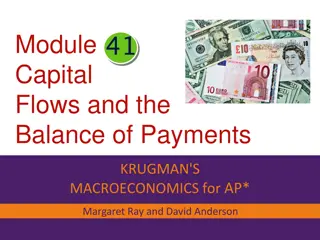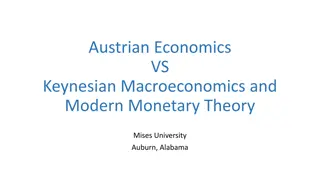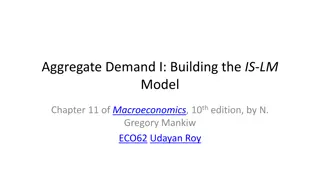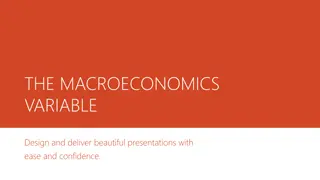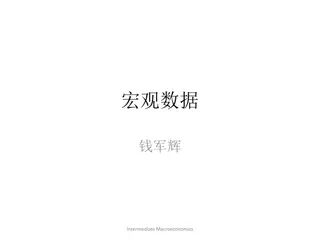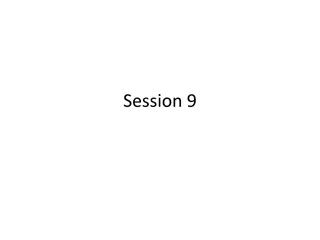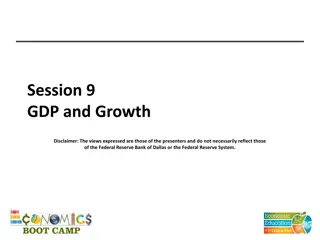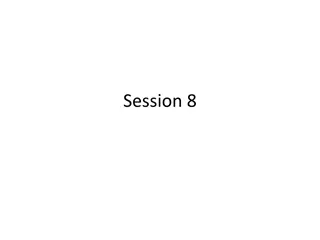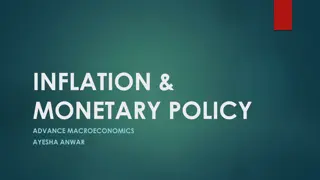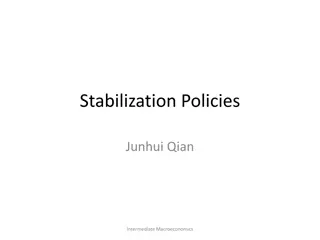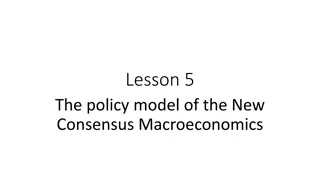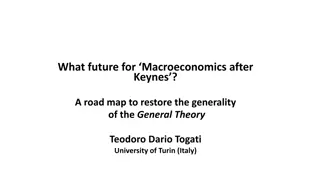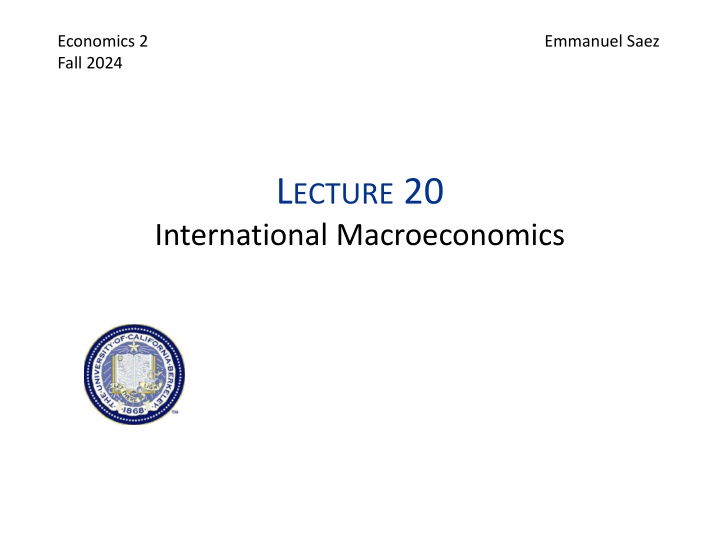
International Macroeconomics Overview
Issues in International Macroeconomics covering topics like exchange rates and balance of payments. Supply and demand framework for exchange rate determination. Understanding foreign exchange markets and their impact on global trade. Explore the dynamics of currencies like the Chinese Yuan. Dive into the complexities of international economic interactions with real-world examples and graphs.
Download Presentation

Please find below an Image/Link to download the presentation.
The content on the website is provided AS IS for your information and personal use only. It may not be sold, licensed, or shared on other websites without obtaining consent from the author. If you encounter any issues during the download, it is possible that the publisher has removed the file from their server.
You are allowed to download the files provided on this website for personal or commercial use, subject to the condition that they are used lawfully. All files are the property of their respective owners.
The content on the website is provided AS IS for your information and personal use only. It may not be sold, licensed, or shared on other websites without obtaining consent from the author.
E N D
Presentation Transcript
Economics 2 Emmanuel Saez Fall 2024 LECTURE 20 International Macroeconomics
Issues in International Macro What determines exchange rates between currencies? The balance of payments and its implications. What determines net exports? NX=exports-imports Net exports (NX) are a component of planned aggregate expenditures. PAE = C + Ip + G + NX So changes in NX will affect Y in the short run.
II. SUPPLYAND DEMAND FRAMEWORKFOR EXCHANGE RATE DETERMINATION
Exchange Rate The price of one currency in terms of another. It currently takes .95 euros to buy 1 U.S. dollar. The price of $1 is .95
Foreign Exchange Market for Dollars Demanders of dollars: Foreigners who want to buy American goods, services, or assets. They need to convert their currency in $ to buy American Suppliers of dollars: Americans who want to buy foreign goods, services, or assets. You need to convert your $ into foreign currency to buy foreign The exchange rate is the price of dollars (in terms of some foreign currency) that equilibrates the supply and demand for dollars to be used in international transactions.
Some Facts about Foreign Exchange Markets There is a market for each currency to be traded for every other currency. However, the various markets for a particular currency (such as the $) often move together . Today, most exchange rates are determined in markets (flexible exchange rates). But, some countries today and many countries in the past used a system of fixed exchange rates. Done through central bank who buys/sells foreign reserves.
Chinese Yuan per 1 US $ FRED Graph China had a fixed exchange rate with the $ in 1999-2005 but now has a floating exchange rate.
Foreign Exchange Market for Dollars: Demand for Dollars Price of $ in Euros ( per $1) D Q of $ Traded Demand for dollars in foreign exchange market: Foreigners who want to buy American goods, services, or assets. They buy American a lot when $ is cheap
Why Does the Demand Curve for Dollars To Be Used in International Transactions Slope Down? If the price of the dollar falls, American goods and services look more attractive (cheaper) to foreigners. Foreigners want to buy more goods and services from the U.S. As a result, they demand more dollars in the foreign exchange market (convert more of their currency into $ to buy American)
Foreign Exchange Market for Dollars: Supply of Dollars Price of $ in Euros ( per $1) S Q of $ Traded Supply of dollars in foreign exchange market : Americans who want to buy foreign goods, services, or assets. They buy more when is cheap in $
Why Does the Supply Curve for Dollars To Be Used in International Transactions Slope Up? If the price of the dollar rises, foreign goods and services look more attractive (cheaper) to Americans. Americans want to buy more goods and services from abroad. As a result, Americans supply more dollars to the foreign exchange market. They convert dollars into foreign currency.
Foreign Exchange Market for Dollars Price of $ in Euros ( per $1) S e1 D Q of $ Traded Q1
A shift in the supply curve or the demand curve for dollars in the foreign exchange market will cause the exchange rate to change. Appreciation of the dollar: The price of the dollar in some foreign currency rises. Depreciation of the dollar: The price of the dollar in some foreign currency falls.
Foreign Exchange Market for Dollars Price of $ in Euros ( per $1) S e1 D Q of $ Traded Q1
France becomes more attractive to US tourists due to a fad for Paris Price of $ in Euros S1 S2 e1 e2 D1 Q of $ Supply of dollars: More Americans want to travel to France and convert $ into Euros for given price: Supply shifts out and dollar falls
Quiz on Exchange Rates Suppose new Trump administration makes it harder for European tourists to visit the United States. A. The demand curve of dollars in the foreign exchange market will shift to the left and the dollar depreciates B. The demand curve of dollars in the foreign exchange market will shift to the right and the dollar appreciates C. The supply curve for dollars in the foreign exchange market will shift to the left and the dollar appreciates D. The supply curve for dollars in the foreign exchange market will shift to the right and the dollar depreciates
Example 2: A Rise in U.S. Real Interest Rates Relative to Those in Japan Recently
Interest Rates in the U.S. and Japan FRED Graph U.S. Japan Source: Federal Reserve Bank of St. Louis, FRED. Demand: Savers in Japan want to buy US bonds instead of Japanese bonds Supply: Savers in the US also want to buy US bonds instead of Japanese bonds
Foreign Exchange Market for Dollars A Rise in the Real Interest Rate in the U.S. Price of $ in S1 e1 D1 Q of $
Foreign Exchange Market for Dollars A Rise in the Real Interest Rate in the U.S. Price of $ in S1 e1 D2 D1 Q of $ Demand: Savers in Japan want to buy US bonds instead of Japanese bonds
Foreign Exchange Market for Dollars A Rise in the Real Interest Rate in the U.S. Price of $ in S2 S1 e2 e1 D2 D1 Q of $ Supply: Savers in the US also want to buy US bonds instead of Japanese bonds Both demand and supply effects increase exchange rate: $ appreciates
Japanese Yen per 1 US $ Source: xe.com.
The real interest rate is affected by monetary policy (in the short run) This means that monetary policy will affect the exchange rate. The effect of the real interest rate on the exchange rate is a key step in the negative relationship between r and NX In a nutshell: If r in US increases, $ appreciates, US goods become more expensive than foreign goods: stimulates imports and depresses exports => NX falls with r.
Example 3: Faster Income Growth in the U.S. than in Japan in the Early 1990s
Real GDP per Capita in U.S. and Japan in 1990s FRED Graph U.S. Japan Source: Federal Reserve Bank of St. Louis, FRED.
Foreign Exchange Market for Dollars Faster Income Growth in the U.S. than in Japan Price of $ in S1 e1 D1 Q of $
Foreign Exchange Market for Dollars Faster Income Growth in the U.S. than in Japan Price of $ in S1 S2 e1 D1 Q of $
Foreign Exchange Market for Dollars Faster Income Growth in the U.S. than in Japan Price of $ in S1 S2 e1 e2 D2 D1 Q of $
Japanese Yen per $1 Source: Federal Reserve Bank of St. Louis, FRED.
Strong vs. Weak Dollar Some terminology: A strong currency is one whose price in terms of other currencies is high. A weak currency is one whose price in terms of other currencies is low.
Balance of Payments An accounting of the supply and demand for dollars used in international transactions
Balance of Payments At the equilibrium exchange rate: Q of $ demanded = Q of $ supplied EX + CI = IM + CO EX: Exports of goods and services (foreigners buy US products) CI: Capital inflows (foreigners buy US assets) IM: Imports of goods and services (Americans buy foreign products) CO: Capital outflows (Americans buy foreign assets)
Balance of Payments from US perspective EX + CI = IM + CO (EX IM) + (CI CO) = 0 EX IM: Net US exports (NX) CI CO: Net US capital inflows (KI) NX + KI = 0 In words: If you export on net, you buy assets abroad. If you import on net, you have to sell some of your assets abroad
Net Exports (NX) and Net Capital Inflows (KI) 1500 KI 1000 500 Billions of $ 0 -500 NX -1000 -1500 1960 1965 1970 1975 1980 1985 1990 1995 2000 2005 2010 2015 2020 Source: Bureau of Economic Analysis
What Determines Net Capital Inflows? The US real interest rate, r: If r rises, American assets become more attractive relative to foreign assets, and so net capital inflows rise. Foreign real interest rates: If real interest rates abroad rise, American assets become less attractive relative to foreign assets, and so net capital inflows fall. Also, tastes for assets: If Americans and/or foreigners find American assets more attractive at a given r, net capital inflows rise.
Implication for Net Exports: The Real Interest Rate Is a Crucial Determinant of NX NX = KI A rise in the real interest rate r raises KI; a fall in the real interest rate r lowers KI. Therefore: A rise in r lowers NX; a fall in r raises NX. Remember PAE(r)=C(r)+I(r)+G+NX(r) All three: C(r), I(r), NX(r) decline with r.
A Rise in the Real Interest Rate in the U.S. Foreign Exchange Market for Dollars Price of $ in Euros S1 e1 D1 Q of $
A Rise in the Real Interest Rate in the U.S. Foreign Exchange Market for Dollars Price of $ in Euros S2 S1 e2 e1 D2 D1 Q of $ The dollar appreciation lowers exports and raises imports, and so lowers NX.
III. SAVING, INVESTMENT, ANDTHE REAL INTEREST RATEINTHE LONG RUNINAN OPEN ECONOMY
The Real Interest Rate r is a crucial determinant of KI, and hence of NX. So: we need to figure out what determines r. We will continue to assume (realistically) that in the short run and in the medium run, r is determined by the Fed responding to inflation according to its reaction function. But, what determines r in the long run?
Saving and Investment in the Long RunThe Case We ve Considering Until Now (NX* = 0) Recall: Y* = C* + I* + G + NX* If NX* = 0, this implies: Y* C* G = I* Using the definition of total savings S=Y-C-G, this implies: S* = I* r* adjusts to bring about S* = I*.
Saving and Investment in the Long Run When NX* Is Not Necessarily Zero Recall: Y* = C* + I* + G + NX* This implies: Y* C* G NX* = I* Grouping the first 3 terms: (Y* C* G) NX* = I* Using NX = KI and the definition of saving: S* + KI* = I* r* adjusts to bring about S* + KI* = I*.
The Real Interest Rate in the Long Run r* S + KI ?1 I ?1 I*, S*+KI* Note: Both saving and net capital inflows are increasing in r.
The Determinants of Our Normal Net Exports NX* = KI*. KI* depends on the domestic real interest rate versus foreign real interest rates and on tastes for domestic versus foreign assets. As a result, usually the best way to figure out how NX behaves in the long run is to figure out what happens to KI in the long run.
Key Messages (about Both the Short Run and the Long Run) NX = KI (and NX* = KI*). The real interest rate is a crucial determinant of KI (and therefore of NX). In a world of international trade and capital flows, the real interest rate in the long run is the one that causes S* + KI* to equal I*.


